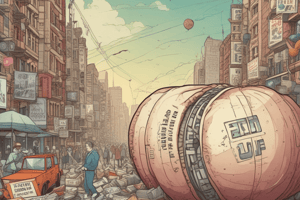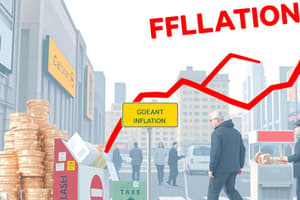Podcast
Questions and Answers
What is one positive effect of inflation mentioned in the text?
What is one positive effect of inflation mentioned in the text?
- Debt relief (correct)
- Distorted price signals
- Income redistribution
- Reduced purchasing power
Which strategy to control inflation involves raising interest rates?
Which strategy to control inflation involves raising interest rates?
- Announcing intention to control inflation
- Setting administrative prices
- Monetary discipline (correct)
- Fixing exchange rates
What is the most common indicator to measure inflation according to the text?
What is the most common indicator to measure inflation according to the text?
- Unemployment rate
- Personal Consumption Expenditures Price Index
- Consumer Price Index (CPI) (correct)
- GDP growth rate
Which of the following is not mentioned as a negative effect of inflation in the text?
Which of the following is not mentioned as a negative effect of inflation in the text?
What is the main cause of demand-pull inflation?
What is the main cause of demand-pull inflation?
What do central bankers aim to influence by announcing their intention to keep economic activity low temporarily?
What do central bankers aim to influence by announcing their intention to keep economic activity low temporarily?
Which segment of the population may experience a decline in real income due to inflation according to the text?
Which segment of the population may experience a decline in real income due to inflation according to the text?
Which factor can lead to cost-push inflation?
Which factor can lead to cost-push inflation?
What is built-in inflation also known as?
What is built-in inflation also known as?
Which strategy could be effective in controlling demand-pull inflation?
Which strategy could be effective in controlling demand-pull inflation?
What is a common effect of cost-push inflation on consumers?
What is a common effect of cost-push inflation on consumers?
How can built-in inflation affect wage negotiations?
How can built-in inflation affect wage negotiations?
Flashcards are hidden until you start studying
Study Notes
Inflation: Types, Effects, Strategies, Measurement, and Causes
Introduction
Inflation is a persistent increase in the general price level of goods and services within an economy over a period of time, often measured annually. It reflects a reduction in the purchasing power of money. Understanding the different types of inflation, their effects, strategies to control them, measurement methods, and causal factors is crucial for making informed economic decisions.
Types of Inflation
There are three main types of inflation: demand-pull, cost-push, and built-in.
Demand-Pull Inflation
Demand-pull inflation occurs when excess demand for goods and services surpasses the available supply, leading to higher prices. Factors contributing to demand-pull inflation include increased consumer confidence, a sudden surge in government spending, or a rapid expansion of the money supply.
Cost-Push Inflation
Cost-push inflation is caused by an increase in production costs, such as wages, raw materials, or energy, which are then passed onto consumers through higher prices. Other factors contributing to cost-push inflation include supply chain disruptions, labor strikes, or changes in government policies affecting production costs.
Built-In Inflation
Built-in or structural inflation arises from the expectation that prices will continue to rise. This expectation leads to a self-perpetuating cycle as businesses and consumers adjust their behavior accordingly, potentially driving further price increases.
Effects of Inflation
Inflation has both positive and negative effects on the economy:
Positive Effects
- Debt Relief: Inflation can reduce the real value of debt, providing relief to borrowers and stimulating economic growth.
- Nominal Wage Growth: Moderate inflation can encourage businesses to increase wages, increasing consumer spending and economic development.
Negative Effects
- Reduced Purchasing Power: As prices rise, the purchasing power of money decreases, leading to a decline in the standard of living.
- Uncertainty: High inflation levels can create uncertainty in the economy, making it difficult for businesses and consumers to plan for the future.
- Distorted Price Signals: Inflation can distort the relative prices of goods and services, making it difficult for businesses to allocate resources efficiently.
- Income Redistribution: Inflation can disproportionately affect different segments of the population, as those with fixed incomes or limited assets may experience a decline in their real income, while those with variable incomes or significant assets may see their wealth increase.
Strategies to Control Inflation
Central banks use various strategies to control inflation, including contractionary policies like raising interest rates, fixing exchange rates, or setting administrative prices. They also rely on their ability to influence inflation expectations.
Monetary Discipline
Some central bankers have chosen to impose monetary discipline by fixing the exchange rate, linking the value of their currency to that of another country, and aligning their monetary policy accordingly. However, this approach may not be effective when inflation is driven by global rather than domestic developments.
Announcing Intention to Control Inflation
Central bankers can announce their intention to keep economic activity low temporarily to bring down inflation, hoping to influence expectations and contracts' built-in inflation component. The more credible the central bank, the greater its influence on inflation expectations.
Measuring Inflation
The most common indicator to measure inflation is the Consumer Price Index (CPI), which tracks the prices of a basket of consumer goods and services over time. Another widely used measure is the Personal Consumption Expenditures Price Index (PCE Price Index), which the Federal Reserve focuses on in its inflation targeting.
Causes of Inflation
Inflation can be caused by various factors, including changes in the supply and demand for goods and services, fluctuations in the money supply, and government policies.
Supply and Demand
Pressures on the supply or demand side of the economy can cause inflation. Supply shocks, such as natural disasters or high oil prices, can reduce overall supply and lead to "cost-push" inflation, while demand shocks, like a stock market rally or expansionary policies, can boost aggregate demand and strain resources, leading to "demand-pull" inflation.
Monetary Policy
Inflation is often linked to the money supply, as an increase in the money supply relative to the economy's size can lead to a depreciation of the currency's purchasing power and rising prices.
Expectations
Expectations play a crucial role in determining inflation, as they influence wage negotiations and contractual price adjustments, partly determining the next period's inflation rate.
Conclusion
Inflation is a complex economic phenomenon that affects individuals, businesses, and governments. Understanding the different types of inflation, their effects, strategies to control them, measurement methods, and causal factors is essential for making informed economic decisions and navigating the complex dynamics of the global economy.
Studying That Suits You
Use AI to generate personalized quizzes and flashcards to suit your learning preferences.




